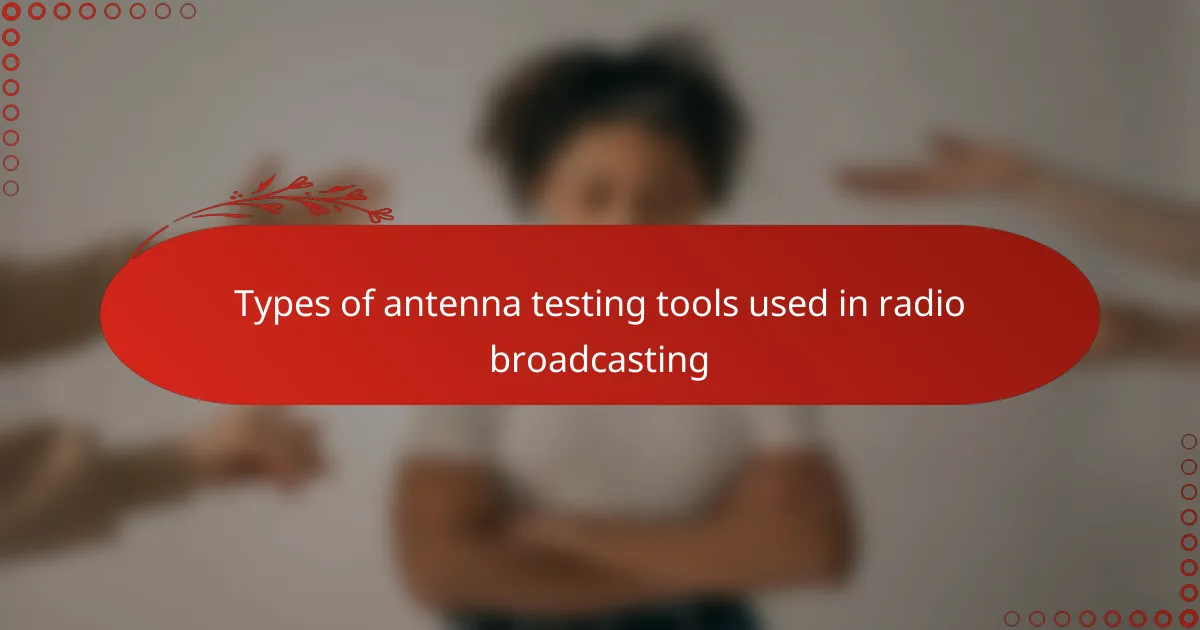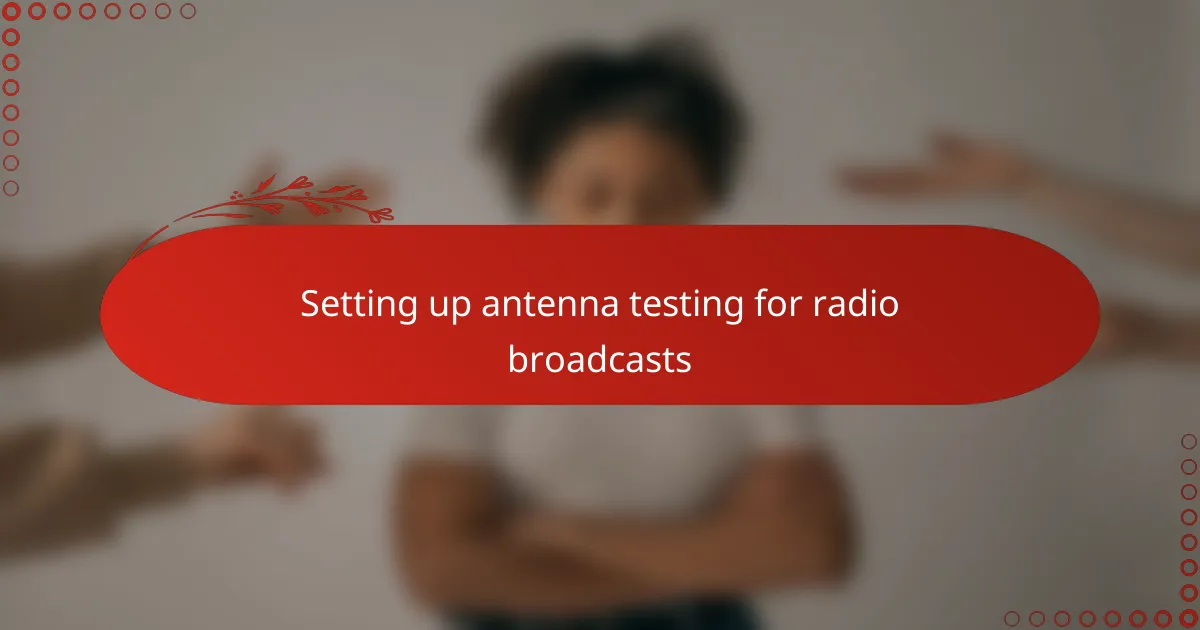Key takeaways
- Antenna testing tools are essential for measuring signal strength, impedance, and radiation patterns to ensure reliable radio broadcasts.
- Accuracy, usability, and versatility are critical features of effective antenna testing tools that enhance the user experience and testing results.
- Common challenges such as environmental interference and impedance matching can be mitigated by thorough calibration, diligent inspection of equipment, and careful documentation of measurements.
- Practicing patience and performing multiple readings under varying conditions can reveal subtle issues that may go unnoticed, improving overall testing outcomes.

Introduction to antenna testing tools
When I first encountered antenna testing tools, I was surprised by how essential they are for ensuring clear and reliable radio broadcasts. These tools help measure key parameters like signal strength, impedance, and radiation patterns, which directly impact how well an antenna performs. Have you ever wondered why some broadcasts come through so crisp while others seem to falter?
From my experience, using these tools isn’t just a technical chore—it’s like tuning a musical instrument. You get a real sense of satisfaction when adjustments based on test results translate into a stronger, cleaner signal. It made me appreciate the intricate balance between engineering and the art of radio transmission.
In practical terms, antenna testing tools range from simple handheld devices to sophisticated analyzers. Each serves a unique purpose, depending on the complexity of the antenna system and the environment. Understanding which tool to use, and when, has been a key part of my learning curve in radio broadcasting.

Types of antenna testing tools used in radio broadcasting
One of the tools I relied on heavily was the antenna analyzer. It’s fascinating how this device can quickly measure impedance and SWR (standing wave ratio) to reveal if the antenna is properly matched to the transmitter. I remember a time when a stubborn interference issue was resolved simply by spotting a mismatch using this tool, which was incredibly satisfying.
Another tool that caught my attention is the field strength meter. It’s almost like having a window into the signal’s real-world reach. By walking around the broadcast area and measuring signal strength, I gained firsthand insight into how environmental factors affect performance. Have you ever wandered with a meter in hand, trying to chase down signal dead zones? It’s both a challenge and an adventure.
Then there are spectrum analyzers, which I found indispensable when dealing with complex frequency environments. They provide a detailed visual landscape of all signals in the air, making it easier to spot interference or unwanted emissions. Using one felt like being a detective, piecing together clues from the signal “crime scene” to ensure a clean broadcast.

Key features of effective antenna testing tools
What I’ve come to value most in effective antenna testing tools is their accuracy. Without precise measurements, you’re essentially flying blind. I recall once trusting a less reliable tool, only to spend hours chasing phantom problems that weren’t really there—accuracy saved me time and frustration every time after that.
Another feature that stands out is usability. Have you ever tried fumbling with complicated menus or tiny buttons while on a tower in brisk weather? I certainly have, and it’s no fun. The best tools are intuitive, letting you focus on the testing itself rather than wrestling with the device.
Lastly, versatility plays a huge role in how often I reach for a tool. The ability to measure everything from signal strength to impedance, and even display real-time spectrum data, all in one device makes a big difference. It’s like having a Swiss Army knife for antenna testing—ready for whatever challenge the broadcast environment throws at you.

Setting up antenna testing for radio broadcasts
Setting up antenna testing for radio broadcasts always feels like preparing for a crucial performance. I remember the first time I had to physically connect measurement devices to an antenna system; ensuring every cable was properly secured and the device calibrated took patience and a steady hand. Have you ever felt that mix of anticipation and focus as you ready your tools, knowing that small setup errors can skew your entire test?
What’s critical in my setup process is establishing a clean, interference-free environment as much as possible. I’ve learned to position the testing equipment away from other electronic devices that might cause false readings. It’s a detail that might seem minor but, trust me, can save you hours of confusion down the line.
Once everything is in place, running preliminary baseline tests has become my ritual. These initial readings often reveal immediate issues, like mismatched impedance or unexpected signal reflections. The satisfaction I get when those first measurements align with expectations – it’s a clear sign that I’m on the right track before diving deeper into adjustments.

Common challenges in antenna testing and solutions
One challenge I often faced during antenna testing was dealing with unpredictable environmental interference. It felt frustrating when strong signals suddenly dropped or noise crept in without warning. Have you ever struggled to pinpoint if the source was nearby machinery, weather conditions, or even unexpected reflections? From my experience, carefully analyzing the spectrum and conducting tests at different times helped isolate these issues, turning guesswork into clear action.
Another persistent hurdle is ensuring accurate impedance matching. I recall a time when hours of fruitless tweaking ended only after realizing the test cables were subtly damaged—something I initially overlooked. This taught me the importance of not just relying on the testing tool itself but also verifying every component in the setup. Regularly inspecting cables and connectors became a simple yet invaluable habit to avoid these hidden pitfalls.
Signal variability caused by physical obstacles like buildings or foliage also gives antenna testing a tricky edge. It’s easy to get discouraged walking around with a field strength meter, seeing uneven results that don’t always make sense. What helped me was mapping these variations and experimenting with antenna positioning or orientation. Small adjustments often made a big difference, reaffirming that patience and persistence are key parts of the process.

My personal methods using antenna testing tools
When I’m working with antenna testing tools, my go-to method always starts with a thorough calibration. It’s a small step, but skipping it once left me chasing phantom issues for hours—something I wouldn’t wish on anyone. Have you ever felt that mix of frustration and relief when a simple calibration instantly makes everything clearer? For me, it’s like resetting the stage before a performance.
Another technique I rely on is combining measurements from different tools to get a fuller picture. For example, I’ll start with the antenna analyzer to check impedance and SWR, then take the field strength meter for a walk around the coverage area. This dual approach keeps me from relying too heavily on just one perspective. From my experience, it’s like looking at a problem from different angles—you catch what you might otherwise miss.
Finally, I always make it a point to document each measurement meticulously. It might sound tedious, but I’ve found that detailed notes and saved readings help me spot trends over time. I remember one occasion when comparing past data led me to identify a slow-developing fault before it became a real headache. Don’t you think having a reliable record turns antenna testing from a guessing game into an informed craft? That’s exactly how I approach it.

Tips and best practices from my experience
One tip that’s become second nature to me is to always double-check your connections before starting any measurement. I can’t count how many times I’ve wasted precious time because a loose cable threw off the entire reading. Have you ever felt that sinking feeling when everything looks fine, but the data just won’t make sense? Trust me, that simple habit saves more headaches than you’d expect.
Also, I’ve learned that patience pays off. Instead of rushing through tests, taking the time to perform multiple readings under different conditions often reveals subtle issues that a single test might miss. I remember spending an afternoon doing just that, and it turned a puzzling signal drop into an easy fix—it felt like solving a satisfying puzzle piece by piece.
Finally, keep your tools well maintained and updated. In one case, an outdated firmware meant I was working with inaccurate data without realizing it. Once updated, my confidence in the results soared. Isn’t it amazing how a small software update can make such a big difference in reliability? Staying on top of these details truly elevates your antenna testing game.
